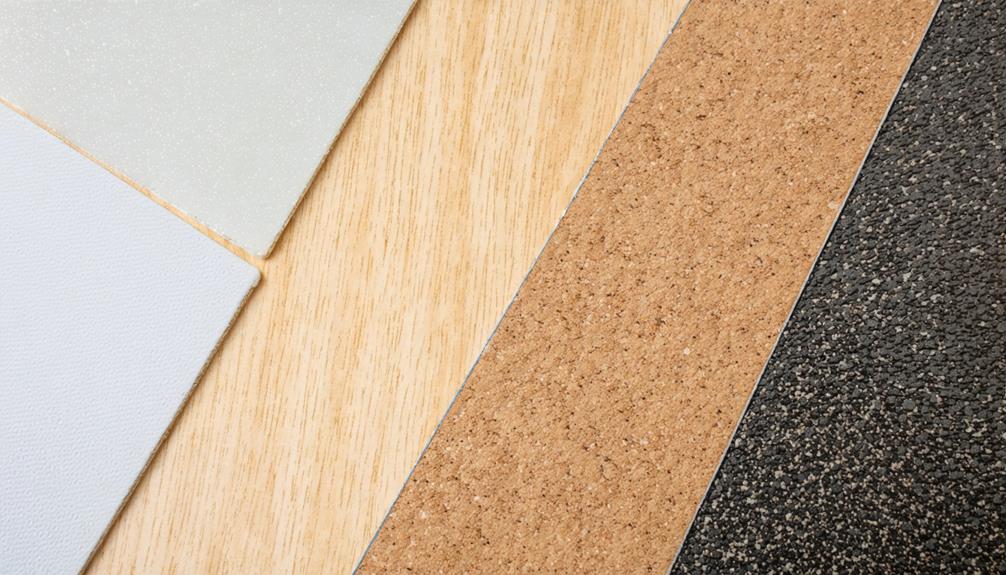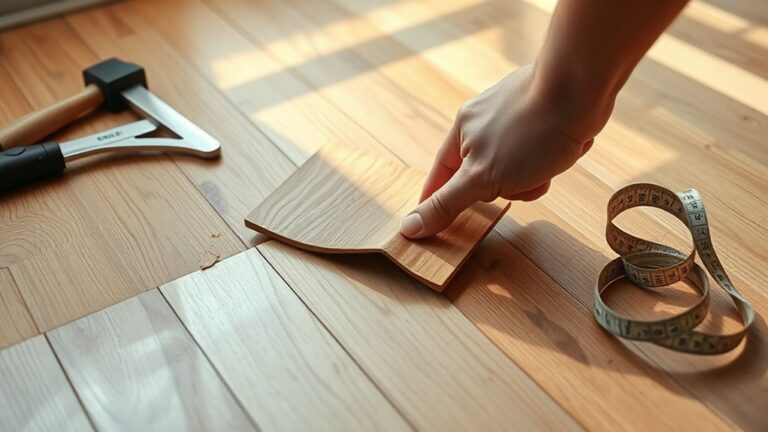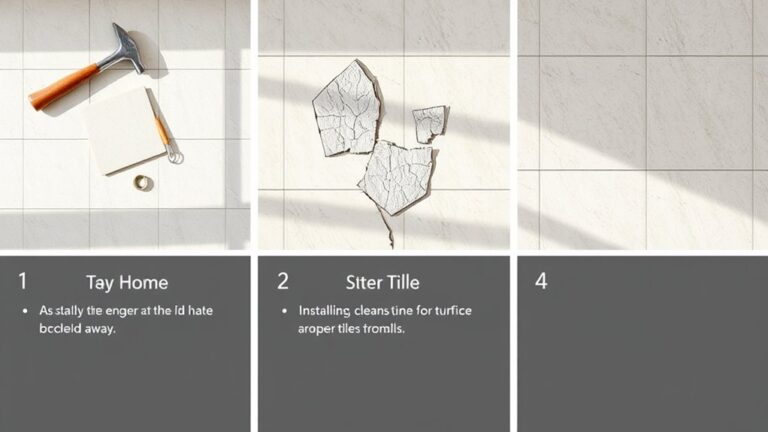When choosing the best underlayment for LVP floors, consider foam, cork, rubber, or felt options. Foam is cost-effective but offers limited moisture resistance. Cork provides excellent sound absorption but requires thickness for best results. Rubber is durable with superior noise dampening and moisture resistance, making it ideal for high-traffic areas. Felt is economical and good for sound insulation, though it's more vulnerable to moisture. Guarantee your chosen underlayment has the right thickness and a moisture barrier, especially in humid environments. With the right selection, you'll optimize your flooring's performance and longevity, and there's more to explore on this topic.
Importance of Underlayment
When it comes to installing LVP flooring, the importance of underlayment can't be overstated. Underlayment acts as a significant barrier between your subfloor and LVP, enhancing durability and extending the lifespan of your flooring by distributing weight evenly. This layer greatly improves comfort underfoot, providing cushioning that's especially beneficial in high-traffic areas or residential spaces where you spend a lot of time.
A quality underlayment plays an essential role in sound reduction, minimizing impact noise from footsteps and other disturbances, which is crucial in multi-story buildings. You'll appreciate the quieter environment it helps create. Furthermore, moisture control is imperative; underlayment with a moisture barrier protects your LVP flooring from potential water damage and mold growth, particularly in damp environments. This feature is a game changer for maintaining the integrity of your flooring.
Additionally, the right underlayment contributes to thermal insulation, enhancing energy efficiency by helping to maintain a comfortable temperature within your space. This means you'll enjoy a cozy environment without over-relying on heating or cooling systems, giving you more control over your living conditions.
Types of Underlayment
Underlayment serves as the unsung hero of your LVP flooring installation, offering various options tailored to meet specific needs. Understanding the types of underlayment available can help you make an informed choice that enhances your flooring's performance and longevity. Here's a quick rundown of some popular options:
- Foam Underlayment: Lightweight and cost-effective, it provides cushioning and noise reduction but has limited moisture resistance. Best for low-moisture areas.
- Cork Underlayment: Eco-friendly and excellent for sound absorption, this option works well in moisture-prone environments but may require a thicker layer for best effect.
- Rubber Underlayment: Highly durable, this type excels in sound dampening, making it perfect for high-traffic areas. It also offers superior moisture resistance, making it a premium choice.
- Felt Underlayment: Made from recycled materials, it provides good sound insulation and cushioning. However, it's more susceptible to moisture, so pairing it with a vapor barrier is advisable in damp conditions.
- Combination Underlayment: This innovative option merges features from different materials, providing tailored solutions for moisture protection and sound dampening, ideal for specific flooring environments.
Each of these types of underlayment caters to different requirements, from sound insulation and cushioning to moisture resistance. When deciding, consider your space's specific needs, especially if you anticipate high traffic or moisture exposure. This thoughtful approach will guarantee your LVP flooring performs beautifully for years to come.
Moisture Protection Factors
Moisture protection is critical for maintaining the integrity of LVP floors, particularly in areas prone to high humidity or potential water exposure. An effective underlayment with a built-in moisture barrier is essential to inhibit water from penetrating the flooring and causing irreversible damage to both the planks and subflooring. This protection is particularly important in preventing mold growth, which can compromise both health and aesthetics.
When selecting underlayment, focus on those with a high moisture resistance rating. Options like recycled rubber or specialty vapor barrier underlayment can greatly enhance the longevity of LVP floors in moisture-prone areas. These materials not only resist moisture but also provide an additional layer of cushioning and thermal insulation.
The effectiveness of your moisture protection is often indicated by the underlayment's perm rating. For vinyl applications, it's advisable to choose underlayment with a perm rating below 1.0, as lower numbers indicate better moisture resistance.
Furthermore, verify that you overlap seams of moisture barriers by at least 6 inches and seal them properly. This simple step can prevent moisture-related issues from infiltrating your flooring system. By prioritizing moisture protection, you're not only safeguarding your investment in LVP floors but also promoting a healthier living environment, free from mold and mildew. This attention to detail will pay off in the long run, guaranteeing the beauty and durability of your flooring choice.
Soundproofing Considerations
Achieving effective soundproofing in LVP flooring is often essential for minimizing noise transmission, especially in multi-story residences or commercial spaces. The right underlayment selection can greatly affect your floors' IIC (Impact Insulation Class) and STC (Sound Transmission Class) ratings. Materials like cork and rubber are especially beneficial for sound insulation. Cork boasts excellent acoustic properties, while rubber excels in dampening impact sound due to its viscoelasticity.
When considering soundproofing, keep the following points in mind:
- Choose quality materials: Opt for underlayment specifically designed for soundproofing, such as Whisper Walk, to considerably reduce footfall noise and echoes.
- Consider thickness: A thicker underlayment generally enhances overall sound absorption. However, always adhere to manufacturer guidelines to prevent flooring instability.
- Evaluate Delta IIC ratings: This rating helps you compare sound performance between different underlayment materials, allowing you to make informed choices prioritizing noise reduction.
Choosing the Right Thickness
Selecting the right thickness for your underlayment is vital for ensuring ideal performance and longevity of your LVP flooring. Generally, the recommended underlayment thickness ranges from 1mm to 3mm. Exceeding this range could void your flooring warranty or create potential installation issues. When you're evaluating thicker underlayment, keep in mind that it can enhance cushioning and sound absorption, making it a great choice for high-traffic areas or noise-sensitive environments.
However, it's important to check the manufacturer guidelines for specific underlayment thickness recommendations, as these can vary based on the type of LVP flooring you choose. Pay attention to the subfloor condition as well; if there are minor imperfections, a thicker underlayment may help mitigate these issues. On the other hand, severe irregularities in the subfloor usually require leveling before you proceed with installation.
Using a higher density underlayment can provide additional support without greatly increasing the thickness, ensuring comfort while maintaining your flooring's integrity. Moisture resistance is another aspect to keep in mind, especially in areas prone to dampness. Thicker underlayment can offer better protection against moisture, but this should also align with the specific requirements set forth by the manufacturer. By understanding these factors, you can confidently select the right underlayment thickness to optimize the performance and durability of your LVP flooring.
Installation Tips
Before you begin installing underlayment, make certain your subfloor is clean, dry, and level to avoid future complications. It's essential to adhere to the manufacturer's guidelines for any adhesives to guarantee peak performance and maintain your warranty. Taking these steps will set a solid foundation for your vinyl planks.
Prepare Subfloor Properly
Proper preparation of the subfloor is indispensable for a successful LVP flooring installation. You need to verify that the subfloor is clean, dry, and level before installing your underlayment for vinyl flooring. Follow these key steps to achieve ideal results:
- Check for moisture: Use a moisture meter to assess concrete subfloors. High moisture levels can lead to complications with both the underlayment and your vinyl flooring.
- Level the surface: If you find significant unevenness, using a leveling compound is essential. A smooth surface prevents voids under the flooring, enhancing its longevity and performance.
- Create a moisture barrier: Overlap moisture barrier seams by at least 6 inches and seal them with tape to establish a continuous barrier against moisture intrusion from below.
Additionally, allow your underlayment to acclimate to the room temperature and humidity for at least 48 hours before installation. This step is critical to prevent expansion or contraction issues that could affect your new flooring. By taking these measures, you set the stage for a successful installation that stands the test of time.
Follow Manufacturer Guidelines
Following the manufacturer's guidelines is essential for achieving ideal results when installing LVP flooring. Start by consulting the manufacturer recommendations for specific underlayment options to guarantee compatibility with your chosen LVP. Adhering to the required underlayment thickness, typically ranging from 1mm to 3mm, is critical to prevent potential damage and maintain warranty coverage.
Next, pay close attention to the specified installation method. Whether it involves staggering seams or employing adhesive, following these instructions guarantees a smooth and even surface for your LVP. Additionally, if you're working with a concrete subfloor, check for any special requirements such as the need for a moisture barrier. This barrier is crucial for protecting your flooring from moisture damage, which can compromise both appearance and longevity.
Common Mistakes to Avoid
When installing LVP flooring, it's vital to avoid common mistakes that can undermine its performance. Selecting the incorrect type of underlayment, overlooking moisture protection, and ignoring soundproofing features can lead to significant issues down the line. Paying attention to these details will guarantee a more durable and comfortable floor.
Selecting Incorrect Type
Selecting the right underlayment for your luxury vinyl plank (LVP) flooring is vital for guaranteeing ideal performance and longevity. Choosing an incorrect type can lead to moisture damage, reduced durability, and voided warranties. It's important to follow manufacturers' recommendations regarding thicknesses and densities, typically ranging from 1mm to 3mm. Ignoring these guidelines may result in installation problems.
When selecting an underlayment, keep these key considerations in mind:
- Comfort underfoot: Verify the underlayment provides adequate cushioning for a pleasant walking experience.
- Best sound: Look for options that enhance noise reduction and have high sound transmission ratings, especially in high foot traffic areas.
- Moisture barrier: In humid spaces, prioritize underlayment with a moisture barrier to prevent mold and mildew growth.
Failing to address these aspects can lead to an uncomfortable living environment and increased noise levels, particularly in multi-story buildings. By investing time into selecting the appropriate underlayment for vinyl, you can avoid common pitfalls and enhance the overall performance of your LVP flooring. Proper installation paired with the right underlayment will guarantee your investment lasts for years to come.
Overlooking Moisture Protection
Many homeowners underestimate the significance of moisture protection when installing luxury vinyl plank (LVP) flooring. Failing to choose an underlayment with a moisture barrier can lead to long-term water damage, especially in areas with high humidity or potential spills. Concrete subfloors are particularly vulnerable, as moisture can easily seep through if you don't have proper moisture resistance in place.
Without adequate moisture protection, you risk developing mold and mildew beneath your flooring, which poses serious health hazards and can lead to costly repairs. Furthermore, skipping a moisture barrier can void your warranty, as manufacturers typically require a specific underlayment for vinyl plank to guarantee durability and performance.
It's essential to check local humidity levels when selecting the right underlayment. By choosing one designed for moisture protection, you're not just safeguarding your investment but also enhancing the longevity of your floors. Remember, protecting your vinyl involves more than just aesthetics; it's about creating a safe, healthy living environment. Prioritize moisture barriers to prevent moisture from seeping in and compromising your beautiful LVP flooring.
Ignoring Soundproofing Features
Neglecting soundproofing features in underlayment can greatly impact the overall comfort of your living space. If you're installing LVP floors, you should prioritize high-quality underlayment with strong soundproofing properties. Failing to take into account the IIC (Impact Insulation Class) and STC (Sound Transmission Class) ratings can lead to noise issues that detract from your enjoyment of the space.
Here are a few key points to remember:
- Underlayment with high IIC and STC ratings considerably reduces noise transmission, making your home more peaceful.
- Choosing underlayment without adequate sound absorption can create echoes and footstep noise, making it less comfortable underfoot.
- Investing in high-quality soundproofing options guarantees long-term satisfaction with your flooring choice.
Recommendations for Subfloor Types
When considering underlayment for your LVP floors, the type of subfloor plays a vital role in determining the best option. For concrete subfloors, you'll find that foam underlayment is ideal for moisture resistance and soundproofing, while cork underlayment offers enhanced thermal insulation and noise absorption. Both options effectively protect your vinyl plank flooring.
If your subfloor consists of plywood or OSB, you should consider felt underlayment for a cost-effective solution. However, if you're after added cushioning and noise reduction, cork or foam underlayment would be more suitable.
In high moisture areas, it's important to select a combined underlayment with a built-in moisture barrier. This protects your LVP flooring from potential damage caused by moisture seeping through the subfloor.
For high-traffic areas, rubber underlayment is highly recommended due to its superior durability and sound dampening capabilities. This makes it particularly beneficial in multi-level buildings, where foot traffic can be disruptive.
Lastly, when dealing with concrete subfloors in multi-story buildings, make sure you select underlayment with a high IIC (Impact Insulation Class) rating. This helps minimize noise transmission between floors, providing a quieter living environment. By choosing the right vinyl plank flooring underlayment based on your subfloor type, you'll enhance the longevity and performance of your flooring.
Frequently Asked Questions
What Is the Best Underlayment for Luxury Vinyl Plank?
Did you know that proper underlayment can reduce noise by up to 50%? When choosing the best underlayment for your luxury vinyl plank, consider options with excellent acoustic properties and a moisture barrier. Cork provides great thermal insulation and sound absorption, while rubber boasts durability factors and low maintenance requirements. Check brand recommendations and perform a cost comparison to find the perfect fit for your needs, ensuring a long-lasting and eco-friendly choice.
What Is the Best Backing for Luxury Vinyl Plank Flooring?
When considering the best backing for luxury vinyl plank flooring, you'll want to focus on installation tips, including ensuring a moisture barrier for longevity. Evaluate sound reduction and thermal insulation properties based on your needs. Durability factors and cost comparison are essential for your budget. Don't overlook maintenance advice and eco-friendly options that align with your values. Finally, keep aesthetic considerations and compatibility issues in mind for a seamless, attractive finish.
What Kind of Padding to Use Under Vinyl Plank Flooring?
Did you know that choosing the right padding can reduce sound transmission by up to 50%? When considering padding types for vinyl plank flooring, focus on durability factors and moisture barriers. Rubber and cork options are excellent for sound insulation and thermal resistance but can vary in cost comparison. For installation tips, make sure proper floor leveling and maintenance requirements are met. Eco-friendly options like cork can be a sustainable choice that meets your needs.
What Underlay Is Best for LVT?
When choosing the best underlay for LVT, you'll want to take into account sound insulation, moisture barrier, and temperature regulation. Look for eco-friendly options that guarantee durability and check compatibility issues with your flooring. Installation tips suggest using a thickness between 1mm to 3mm for peak performance. Cost comparison is essential, so evaluate brand recommendations for reliable choices. Don't forget maintenance advice to enhance longevity and keep your floors looking great!




